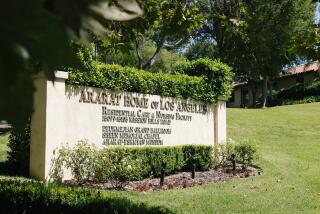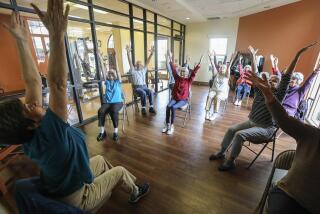Reliable nursing home information can be difficult to get
When Woodland Hills resident Amy Regenstreif was diagnosed with cancer in 2001, it was her elderly mother she worried about most.
The survival rate for Regenstreif’s cancer, a rare form called leiomyosarcoma, was only five years and she worried that cancer treatments and side effects would prevent her from caring for her mother, who lived with her and for whom she was financially responsible.
“I called up the Jewish Home [in Los Angeles] and said, ‘You have to take my mom,’ because I didn’t know if I was going to be here or not,” she says. “I was petrified I was going to have to put my mom in a horrible place.”
Regenstreif’s father had previously lived in a nursing home, where she says she would visit and find him sitting in bed in a pool of urine, see residents not properly bathed and find that nurses were talking on the phone to boyfriends while buzzers were going off from patients needing assistance. She ended up placing him elsewhere, but she didn’t want to have the same experience with her mother.
The long-term-insurance saleswoman was fortunate to get her mother placed in the Jewish Home; she’s been battling the cancer for eight years and her mother thrived there until her death this past March.
Among Americans older than 65, almost 40% will eventually find themselves in a nursing home. But the choice of a facility is often made during a crisis -- with a sudden hospitalization coming to an end, perhaps, and an elderly person in no position to care for herself or himself.
Ideally, consumers would have a wealth of data and reports and clear-eyed assessments of nursing home quality. As of now, that’s not the case.
Although the Centers for Medicare and Medicaid Services created a website called Nursing Home Compare in 1998 -- providing information on nursing homes certified by Medicare and Medicaid including ownership of the home and characteristics of its residents, staffing and quality -- the site’s usefulness has been criticized since its inception.
Legislation being considered as part of healthcare reform bills in the House and Senate would make the site more accurate and comprehensive.
That legislation, the Nursing Home Transparency and Improvement Act, would require the site to provide more precise data on staffing ratios and facility ownership, and improve and accelerate the complaint process. It would also require the Department of Health and Human Services to scrutinize the site to ensure the information provided is clear to consumers.
The bill has long been awaited by advocates of nursing home reform.
“I think all of us would turn there [to the site] first, even though we are skeptical of it,” says Janet Wells, policy director for the National Citizen’s Coalition for Nursing Home Reform, which provides advocacy, education and policy analysis on nursing home reform issues. “My concern is that people don’t understand you can’t just pick the best rating and assume that it will give an idea of what the care of a facility is like.”
Shortcomings
Currently, the site lists only complaints that are substantiated, which is a problem, says Pat McGinnis, executive director of California Advocates for Nursing Home Reform. McGinnis estimates that a mere 25% of complaints are substantiated because backlogs at health departments delay investigations until witnesses are gone or residents have died. She also questions the staffing ratios listed -- a major indicator of quality -- because they are self-reported.
Further, the site’s quality measures are skewed, she says. Because homes are rated on the number of patients who need acute care, facilities providing care for a high number of such patients are generally rated lower than others.
“Nursing Home Compare makes some of the worst facilities look like some of the best and vice versa,” McGinnis says.
A 2002 report by the Special Investigations Division of the Committee on Government Reform in the U.S. House found that numerous complaints were not disclosed on Nursing Home Compare.
Among the allegations: that a staff member at one facility repeatedly exposed himself to a female resident, that some homes allowed residents to wander outside in freezing weather, that some failed to treat patients with obviously broken bones, and that a patient with a urinary tract infection was not monitored properly, resulting in a drop in blood pressure and, ultimately, her death.
A spokeswoman for the Centers for Medicare and Medicaid Services acknowledged the limitations of the site. “It’s frustrating sometimes because things happen that are difficult to document because the nursing staff is not likely to report mistakes they made,” says Mary Kahn, a CMS spokeswoman.But she adds: “Nursing Home Compare is not the only tool for families to use -- it is not intended to be that, and is impossible for it to be that.”
Get a full picture
That’s not to say consumers can’t make better-informed choices. Kahn recommends that families use the site by printing out a facility’s inspection, taking it to the facility and reviewing it with the staff to see what kind of improvements are being made.
The site’s current assets, Kahn says, include a three-year listing of health inspection results and a comparison of how facilities compare statewide and nationally on 19 quality measures. It also lists homes that are part of a special focus facility project; those that are the poorest performers and thus receive technical assistance from the Centers for Medicare and Medicaid Services are marked with an icon denoting them as such.
And although there may be a dearth of consumer-friendly information out there, families can nonetheless gain insight into the kind of care a home provides. (See sidebar.)
Each state also has an ombudsman program through its department of health, which tracks complaints and issues in the homes. Ombudsmen are often willing to speak frankly about area facilities, says Larry Minnix, chief executive of the American Assn. of Homes and Services for the Aging, a nonprofit organization that represents not-for-profit elder care facilities. California ombudsmen offices are parceled out by county; the Los Angeles office can be reached at (310) 393-3618 or (800) 334-9473.
Families can also find information on the most recent state survey of a facility (Form 2567) posted in a public area at the nursing home. It will have information on deficiencies and citations found during the most recent state inspection. Inspections should be held by the state every 12 to 15 months on behalf of CMS.
Complaints filed against a facility are also important indicators of the quality of a facility, McGinnis adds. Substantiated complaints can be found at each state Department of Health. In California, the information can be found at the Health Facilities Consumer Information System online at hfcis.cdph.ca.gov/default.aspx. McGinnis says it is important to consider complaints because they are difficult to file, particularly by residents and families who are often afraid of recourse.
But maybe one of the most important ways to ascertain whether a facility will be a good fit for a family member is to discuss it with him or her.
“If you can, you ought to have a conversation among family members and ask them which ones (facilities) they would want the family to explore,” Minnix says. “If they don’t want to talk about it, tell them you just want to know their wishes.”






